JW Marriott Dongdaemun Square Seoul (JW 메리어트 동대문 스퀘어 서울)
7.1Km 2021-02-17
279, Cheonggyecheon-ro, Jongno-gu, Seoul
+82-2-2276-3000
JW Marriott Dongdaemun Square Seoul is located at the fusion of culture, entertainment and commerce in the dynamic Dongdaemun and is JW Marriott’s second hotel to open in Seoul. The hotel has 170 guest rooms, including 15 suites, a swimming pool, 24-hour fitness center, and full-service spa, all for the convenience of its guests.
JW Marriott Dongdaemun Square Seoul has four meeting rooms, including the Grand Ballroom, a modern, yet refined space housing a cutting-edge 98 screen Samsung LFD media wall to ensure that every event held in the ballroom is a success. The hotel also has a variety of dining options including the internationally renowned steakhouse BLT Steak, Tavolo 24 which serves breakfast, lunch and dinner, The Lounge, The Griffin Bar, and Seoul Baking Company.
The Riverside Hotel (더 리버사이드 호텔)
7.1Km 2020-06-09
6, Gangnam-daero 107-gil, Seocho-gu, Seoul
+82-2-6710-1105
Located in Jamwon-dong, the transportation hub of Seoul and the center of the Gangnam business area, The Riverside Hotel has outstanding views of the Hangang River and downtown Seoul. The hotel is located a convenient 5-minute walk from Sinsa Station (Subway Line 3). At The Riverside Hotel, guests can enjoy dining, leisure, and culture.
All guestrooms look out on the magnificent nightscape of the Hangang River. Subsidiary facilities include a conference and wedding hall, a top-quality Japanese restaurant, a custom-tailored fitness system, a luxurious spa, an indoor driving range, 24-hour interpretation service, and customer service provided by English and Japanese speaking staff. The beautiful interior decorations and comfort items make a stay in The Riverside Hotel feel like home, perfect for business travelers.
Spa Lei (스파레이)
7.1Km 2022-09-19
Gangnam-daero 107-gil 5, Seocho-gu, Seúl
Situado en el barrio de Jamwon-dong, distrito de Seocho-gu de Seúl, el Spa Lei es un jjimjilbang y sauna exclusivos para mujeres que presenta una ambientación europea, con instalaciones de alta clase y una variedad de prácticas instalaciones.
Barrio del Tteokbokki de Sindang-dong (신당동 떡볶이 골목)
7.1Km 2022-09-22
Dasan-ro 33-gil 10-18, Jung-gu, Seúl.
El Barrio del Tteokbokki de Sindang-dong se remonta a los años 70 del siglo XX, pero su mayor auge llegó en los años 80. Además de ser presentado en programas de televisión populares de la época, el período también fue marcado por los mejores tiempos del béisbol de la escuela de secundaria, donde los estudiantes se aglomeraban en las calles durante los partidos entre la Escuela Duksoo Commercial y la Escuela Sunrin Commercial (ahora Sunrin Internet). Pasados los años, los antiguos estudiantes de la escuela siguen visitando la zona para recordar su juventud y seguir comiendo el especial tteokbokki. Sin embargo, algunos dicen que la historia de este barrio empezó en los años 50. La propietaria del restaurante Mabokrim Halmeoni Tteokbokki dice que el tteokbokki se empezó a vender en el año 1953, cuando en la zona estaba el teatro Donga y ella vendía tteokbokki, maíz y patatas a los visitantes. En un principio, el tteokbokki estaba simplemente hecho de gochujang, pero se fueron añadiendo ingredientes como huevos, fideos, pasta de pescado, y más recientemente calamar, gambas y queso para darle un mejor sabor; y lo que era una simple merienda se ha convertido en un plato principal.
Jongjeom Tteokbokki (종점 떡볶이)
7.1Km 2020-04-09
217-1, Dasan-ro, Jung-gu, Seoul
+82-2-2234-3649
Jongjeom Tteokbokki opened in 1978 and has been a popular restaurant on Sindang-dong Tteokbokki Street since then. The restauant serves a special meal option of adding fried rice to tteokbokki.
Urijip Tteokbokki (우리집떡볶이)
7.1Km 2020-04-09
217-1, Dasan-ro, Jung-gu, Seoul
+82-2-2232-4531
Opened in 1979, Urijip Tteokbokki has operated for over 30 years in the same location. This restaurant has a spacious basement area which can accommodate up to 100 people. The restaurant is especially popular among Japanese tourists.
I Love Sindangdong Tteokbokki (아이러브신당동떡볶이)
7.1Km 2020-04-10
50, Toegye-ro 76-gil, Jung-gu, Seoul
+82-2-2232-7872
I Love Sindangdong Tteokbokki is a tteokbokki (spicy rice cakes) restaurant opened in 2001 when seven tteokbokki restaurants with over 25 years of history joined together. A DJ plays music and tells stories to the guests. The restaurant also features a stage with an acoustic guitar for live performances. Order and delivery service is available via the website.
Seokparang (석파랑)
7.1Km 2025-05-19
309, Jahamun-ro, Jongno-gu, Seoul
Parque Montmartre (몽마르뜨공원)
7.1Km 2021-11-25
Banpo-daero 37-gil 59, Seocho-gu, Seúl
+82-2-2155-6877
El lugar del Parque Montmartre era anteriormente era una montaña abandonada pero en el año 2000, bajo el proyecto de la urbanización del Ayuntamiento de Seúl, se convirtió en un parque verde acudido por los ciudadanos todo el año. La entrada al barrio Seorae, zona residencial muy cerca del parque, era conocida como Montmartre, por lo que se llegó a llamarlo con el mismo nombre.
Puerta Heunginjimun (Dongdaemun) (흥인지문)
7.1Km 2023-02-21
Jong-ro 288, Jongno-gu, Seúl
La puerta Dongdaemun fue originalmente llamada Heunginjimun, y es la antigua entrada oriental a la ciudad de Hanyang (Seúl).
Dongdaemun fue edificada por el rey Taejo in 1396, renovada por el rey Danjong en 1453, y su actual estructura fue hecha por el rey Gojong en 1869. Aparentemente, la gente comenzó a llamarla Heunginjimun desde los tiempos del rey Sejo (1455-1468). Pese a que la puerta es conocida en general con el nombre de Dongdaemun, mucha gente aún la sigue denominando Heunginjimun, con la intención de preservar su antiguo legado.
La característica más interesante de Dongdaemun es que tiene un ongseong, un muro externo especialmente construido con forma de media luna. Originalmente, el palacio real en Hanyang se había erigido sobre un terreno bajo, por lo que era difícil defenderlo de las invasiones. Por ello, hicieron levantar un muro para compensar dichas desventajas. Se puede observar que la puerta fue hecha teniendo en consideración la geografía del entorno. Las rocas de ongseong tienen diferentes colores, que fueron cambiando a través de las diversas obras de renovaciones que sufrió la puerta.
En el centro del muro reforzado de piedra se encuentra la puerta más pequeña Hongyemun. Sobre esta, se halla el piso intermedio compuesto de cinco secciones y el techo tiene el estilo llamado "de Ujingak". En los aleros del techo están las estatuas japsang, que se parecen a animales y se dice que espantan a los espíritus malignos. La estructura de Dongdaemun tiene una intrincada técnica de los detalles y hay una gran exaltación de la decoración, con lo que muestra muy bien el estilo de la arquitectura que había en los últimos tiempos del período Joseon.

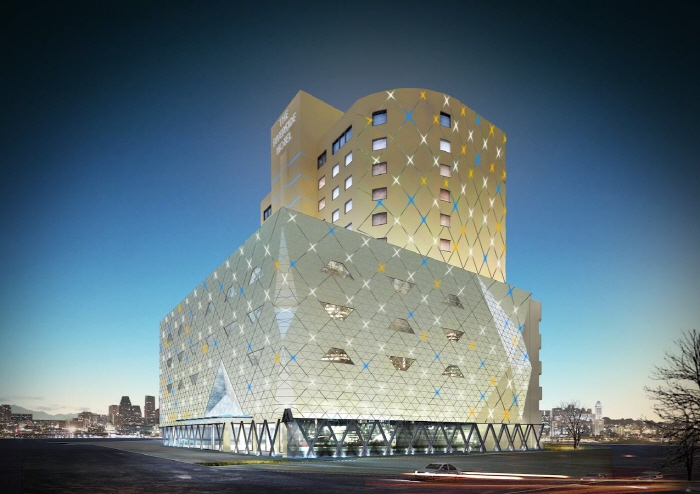

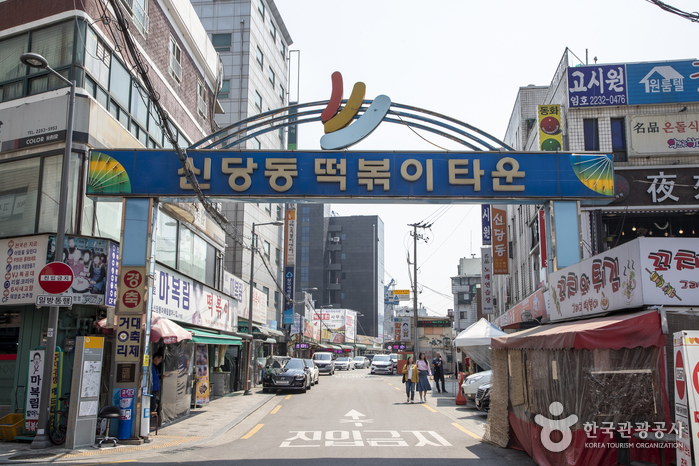
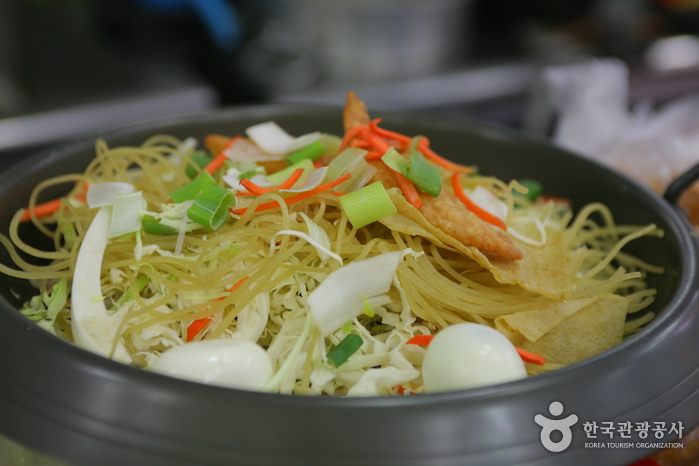


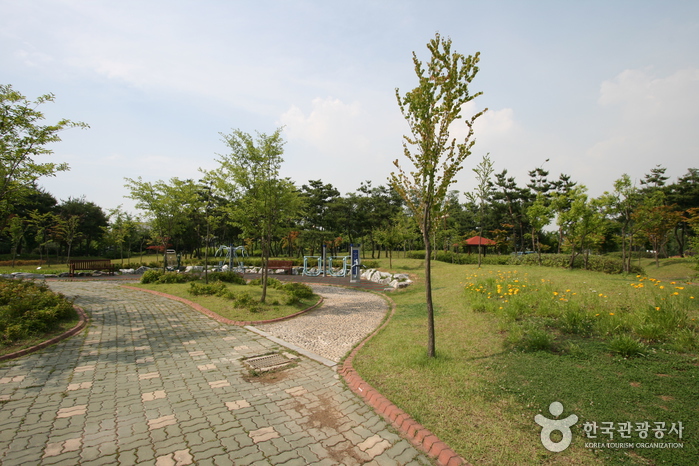
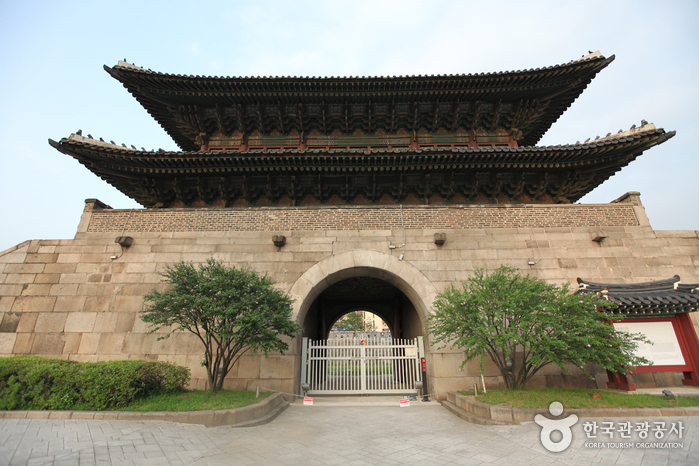
 Español
Español
 한국어
한국어 English
English 日本語
日本語 中文(简体)
中文(简体) Deutsch
Deutsch Français
Français Русский
Русский